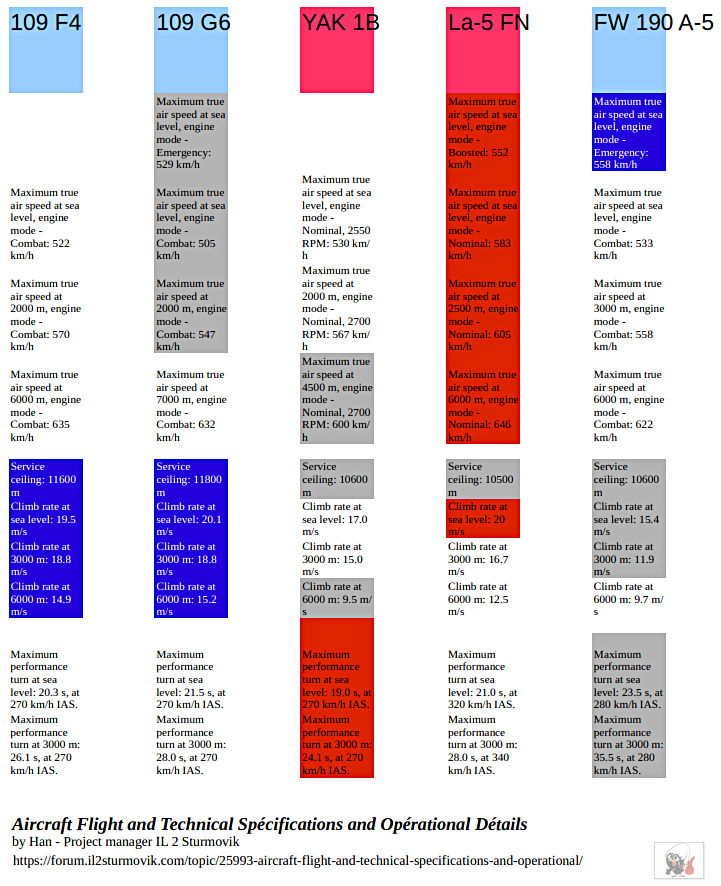
Vidéo de découverte de Requiem:
Indicated stall speed in flight configuration: 168..185 km/h
Indicated stall speed in takeoff/landing configuration: 147..159 km/h
Dive speed limit: 720 km/h
Maximum load factor: 10 G
Stall angle of attack in flight configuration: 22.2 °
Stall angle of attack in landing configuration: 15.0 °
Maximum true air speed at sea level, engine mode - Boosted: 552 km/h
Maximum true air speed at sea level, engine mode - Nominal: 583 km/h
Maximum true air speed at 2500 m, engine mode - Nominal: 605 km/h
Maximum true air speed at 6000 m, engine mode - Nominal: 646 km/h
Service ceiling: 10500 m
Climb rate at sea level: 20 m/s
Climb rate at 3000 m: 16.7 m/s
Climb rate at 6000 m: 12.5 m/s
Maximum performance turn at sea level: 21.0 s, at 320 km/h IAS.
Maximum performance turn at 3000 m: 28.0 s, at 340 km/h IAS.
Flight endurance at 3000 m: 2.0 h, at 350 km/h IAS.
Takeoff speed: 175..195 km/h
Glideslope speed: 200..210 km/h
Landing speed: 150..160 km/h
Landing angle: 13 °
Note 1: the data provided is for international standard atmosphere (ISA).
Note 2: flight performance ranges are given for possible aircraft mass ranges.
Note 3: maximum speeds, climb rates and turn times are given for standard aircraft mass.
Note 4: climb rates and turn times are given for Boosted power.
Engine:
Model: M-82FN
Maximum power in Boosted mode at sea level: 1850 HP
Maximum power in Nominal mode at sea level: 1560 HP
Maximum power in Nominal mode at 1550 m: 1630 HP
Maximum power in Nominal mode at 4800 m: 1460 HP
Engine modes:
Nominal (unlimited time): 2400 RPM, 1000 mm Hg
Boosted power (up to 10 minutes): 2500 RPM, 1180 mm Hg
Oil rated temperature in engine intake: 65..75 °C
Oil maximum temperature in engine intake: 85 °C
Cylinder head rated temperature: 180..215 °C
Cylinder head maximum temperature: 250 °C
Supercharger gear shift altitude: 3500 m
Empty weight: 2655 kg
Minimum weight (no ammo, 10% fuel): 2929 kg
Standard weight: 3305 kg
Maximum takeoff weight: 3544 kg
Fuel load: 334 kg / 464 l
Useful load: 896 kg
Forward-firing armament:
2 x 20mm gun "SsVAK", 170 rounds, 800 rounds per minute, synchronized
Bombs:
2 x 50 kg general purpose bombs "FAB-50sv"
2 x 104 kg general purpose bombs "FAB-100M"
Length: 8.672 m
Wingspan: 9.8 m
Wing surface: 17.51 m^2
Combat debut: June 1943
Additional airplane configurations list:
Loadout variants: armour piercing (AP) or high-explosive (HE) rounds only
2 x 50 kg General Purpose Bombs FAB-50sv
Additional mass: 120 kg
Ammunition mass: 100 kg
Racks mass: 20 kg
Estimated speed loss before drop: 20 km/h
Estimated speed loss after drop: 12 km/h
2 x 104 kg General Purpose Bombs FAB-100M
Additional mass: 228 kg
Ammunition mass: 208 kg
Racks mass: 20 kg
Estimated speed loss before drop: 27 km/h
Estimated speed loss after drop: 12 km/h
Landing light for night flights
Additional mass: 2 kg
Estimated speed loss: 0 km/h
RPK-10 fixed loop radio compass for navigation with radio beacons
Additional mass: 10 kg
Estimated speed loss: 0 km/h
Rear view mirror
Additional mass: 1 kg
Estimated speed loss: 0 km/h
Operation features:
- The engine has a boost mode. To engage it, increase the manifold pressure to 1180 mm Hg. Boost only works on 1st supercharger gear.
- Engine has a two-stage mechanical supercharger which must be manually switched at 3500m altitude.
- Engine RPM has an automatic governor and it is maintained at the required RPM corresponding to the governor control lever position. The governor automatically controls the propeller pitch to maintain the required RPM.
- Oil radiator, air cooling intake and outlet shutters are manually controlled.
- Air cooling intake shutters should always be open. They should only be closed when there is a possibility of engine overcooling, for example in a dive with idle throttle.
- Aircraft is equipped with elevator and rudder trimmers.
- Airplane has automatic wing slats. They deploy when the high angle of attack increases which makes pre-stall softer.
- Landing flaps have a hydraulic actuator and they can be extended to any angle up to 60°.
- Airplane tail wheel rotates freely and does not have a lock. For this reason, it is necessary to confidently and accurately operate the rudder pedals during the takeoff and landing.
- Airplane has differential pneumatic wheel brakes with shared control lever. This means that if the brake lever is held and the rudder pedal the opposite wheel brake is gradually released causing the plane to swing to one side or the other.
- Airplane has a fuel gauge which shows total remaining fuel.
- Also, it is impossible to open or close canopy at high speed due to strong airflow. The canopy has no emergency release, so bail out requires the speed drop before it.
- The control system for the bomb rack only allows to drop bombs one by one.






